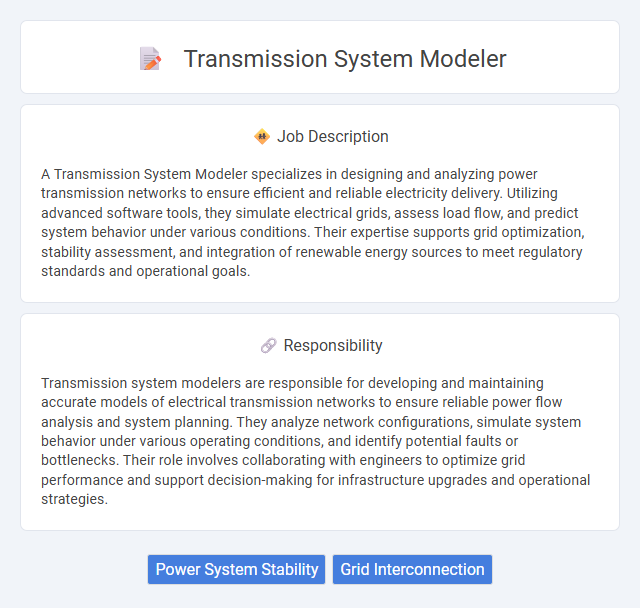
A Transmission System Modeler specializes in designing and analyzing power transmission networks to ensure efficient and reliable electricity delivery. Utilizing advanced software tools, they simulate electrical grids, assess load flow, and predict system behavior under various conditions. Their expertise supports grid optimization, stability assessment, and integration of renewable energy sources to meet regulatory standards and operational goals.
Individuals with strong analytical skills and a background in electrical engineering may likely be well-suited for a Transmission System Modeler role, as it often requires detailed understanding of power systems and simulation software. Candidates who enjoy problem-solving and working with complex data sets could probably find this job engaging and rewarding. Those who prefer routine tasks or lack interest in technical modeling might experience challenges adapting to this position.
Qualification
A Transmission System Modeler requires a strong background in electrical engineering or power systems, often demonstrated by a bachelor's or master's degree in these fields. Proficiency in modeling software such as PSS(r)E, PowerFactory, or MATLAB is essential for accurate simulation and analysis of transmission networks. In-depth knowledge of power system dynamics, load flow studies, and fault analysis enhances the ability to optimize grid performance and reliability.
Responsibility
Transmission system modelers are responsible for developing and maintaining accurate models of electrical transmission networks to ensure reliable power flow analysis and system planning. They analyze network configurations, simulate system behavior under various operating conditions, and identify potential faults or bottlenecks. Their role involves collaborating with engineers to optimize grid performance and support decision-making for infrastructure upgrades and operational strategies.
Benefit
A Transmission System Modeler likely enhances grid reliability and efficiency by simulating and analyzing power transmission networks, which may reduce operational risks and downtime. This role could lead to improved decision-making through accurate modeling and forecasting of system behavior under various conditions. Professionals in this position might also enjoy increased job stability and the opportunity to work with advanced simulation tools in a cutting-edge energy sector.
Challenge
The Transmission System Modeler role likely involves navigating complex electrical grid simulations requiring precise data interpretation and integration. Challenges may arise in maintaining model accuracy amid evolving transmission technologies and regulatory changes. Effective problem-solving and adaptability could be critical to anticipating system behavior and optimizing grid performance.
Career Advancement
A Transmission System Modeler plays a critical role in designing and optimizing electrical power grids, utilizing advanced simulation software and data analytics to ensure system reliability and efficiency. Mastery in electrical engineering principles and proficiency with industry-standard tools like PSS(r)E and PowerWorld can accelerate progression to senior engineering roles or specialized positions such as Grid Reliability Analyst. Pursuing certifications in power systems and gaining experience with smart grid technology enhances prospects for leadership opportunities and strategic project management within utility companies or consultancy firms.
Key Terms
Power System Stability
Transmission System Modelers specialize in designing and validating dynamic models that simulate power system behavior under various operating conditions to ensure stability and reliability. Expertise in transient stability analysis, fault diagnosis, and load flow studies using software such as PSS(r)E or PSLF is critical for predicting system responses to disturbances. Their work directly supports grid operators in maintaining system frequency, voltage stability, and preventing cascading failures in interconnected power networks.
Grid Interconnection
Transmission system modelers specializing in grid interconnection develop detailed simulations to analyze the integration of renewable energy sources and new power plants into existing electrical grids. They use advanced software tools like PSS(r)E and PowerFactory to evaluate system stability, load flow, and fault analysis, ensuring seamless and reliable energy transmission. Their work supports utility companies and grid operators in optimizing network performance and maintaining compliance with industry standards and regulatory requirements.
 kuljobs.com
kuljobs.com